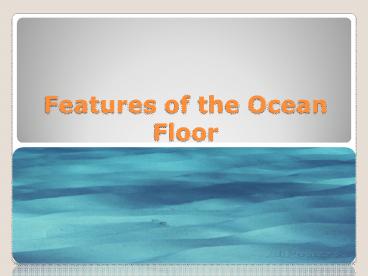Features of the Ocean Floor - PowerPoint PPT Presentation
1 / 21
Title:
Features of the Ocean Floor
Description:
Features of the Ocean Floor Essential Question What does the Ocean Floor Look Like Sketch a picture of your hypothesis. Features of the Ocean Floor Continental shelf ... – PowerPoint PPT presentation
Number of Views:906
Avg rating:3.0/5.0
Title: Features of the Ocean Floor
1
Features of the Ocean Floor
2
Exploration Time Line
- 1915
- Scientists aboard the German ship Meteor used
sonar to map the ocean floor. They used the
device called echo sounder to produce pulses of
sound. The ships crew then timed the return of
the echoes
3
German Ship Meteor
4
Exploration time line
- 1943
- Jacques Cousteau and Emile Gagnan invented SCUBA,
which stands for Self Contained Underwater
Breathing Apparatus. A tank containing
compressed air is strapped to the divers back
and connected by a tube to a mouthpiece. SCUBA
enables divers to explore to a depth of 40
meters.
5
First SCUBA gear 1943
6
Exploration time line
- 1960 submersibles
- Vehicles with very thick metal hulls protect
explorers from extreme pressure and temperature,
while enabling them to directly observe the ocean
depths.
7
Alvin was the first deep-sea submersible capable
of carrying passengers, usually a pilot and two
observers. Its first untethered dive measured 35
ft. Now, after numerous upgrades and
reconstructions, Alvin can plunge to a maximum
depth of 14,764 ft.
1964
8
Exploration Time Line
- 1978 Satellites
- Seasat A was the first satellite in Earths orbit
to study the oceans. Since satellites make
millions of observations a day, they provide data
on rapidly changing and widespread ocean
conditions. Such data include temperatures, algae
growth patterns, and even the movement of large
schools of fish.
9
Specific objectives were to collect data on
sea-surface winds, sea-surface temperatures, wave
heights, internal waves, atmospheric water, sea
ice features and ocean topography
10
(No Transcript)
11
Features of the Ocean Floor
- Continental shelf a gently sloping, shallow area
of the ocean floor - 1. The actual boundary of a continent is not its
coastline, but the edge of the continental shelf. - 2. Most continental shelves are broad, gently
sloping plains covered by relatively shallow
water. - 3. Water depth over the continental shelves
averages about 60 meters (200 feet). - 4. Sunlight penetrates the shallow waters, and
many kinds of organisms flourishfrom microscopic
shrimp to giant seaweed called kelp. - 5. Ocean currents and runoff from rivers bring
nutrients to organisms that live on continental
shelves
12
(No Transcript)
13
Continental Slope
- 1. This marks the true edge of a continentment,
where the rock that makes up the continent slops
and the rock of the ocean floor begins. - 2. The gradient of the slope is lowest off stable
coasts without major rivers and highest off
coasts with young mountain ranges and narrow
continental shelves. - 3. Most Pacific slopes are steeper than Atlantic
slopes. Gradients are flattest in the Indian
Ocean.
14
(No Transcript)
15
Seamounts
- Mountains that are completely underwater.
- Seamounts - undersea mountains formed by volcanic
activity - were once thought to be little more
than hazards to submarine navigation. - Today, scientists recognize these structures as
biological hotspots that support a dazzling array
of marine life. - The biological richness of seamount habitats
results from the shape of these undersea
mountains. - Thanks to the steep slopes of seamounts,
nutrients are carried upwards from the depths of
the oceans toward the sunlit surface, providing
food for creatures ranging from corals to fish to
crustaceans.
16
(No Transcript)
17
Abyssal Plain
- A broad area covered with thick layers of mud and
silt. - The plains are largest and most common in the
Atlantic Ocean, less common in the Indian Ocean,
and even rarer in the Pacific, where they occur
mainly as the small, flat floors of marginal seas
or as the narrow, elongate bottoms of trenches.
18
(No Transcript)
19
Mid-Ocean Ridge
- A continuous range of mountains that winds around
Earth, much as the line of stitches winds around
a baseball. - At the top of the mid-ocean ridge, about 2
kilometers above the abyssal plain, but still 1
kilometer below the surface. - It consists of two parallel chains of mountains
separated by a central valley.
20
(No Transcript)
21
Sonar
- Sound Navigation and Ranging, is a system that
uses sound waves to calculate the distance to an
object. - The sonar equipment on a ship sends out pulses of
sound that bounce off the ocean floor. - The equipment then measures how quickly the sound
waves return to the ship. - Sound waves take longer to return if the ocean
floor is farther away.































